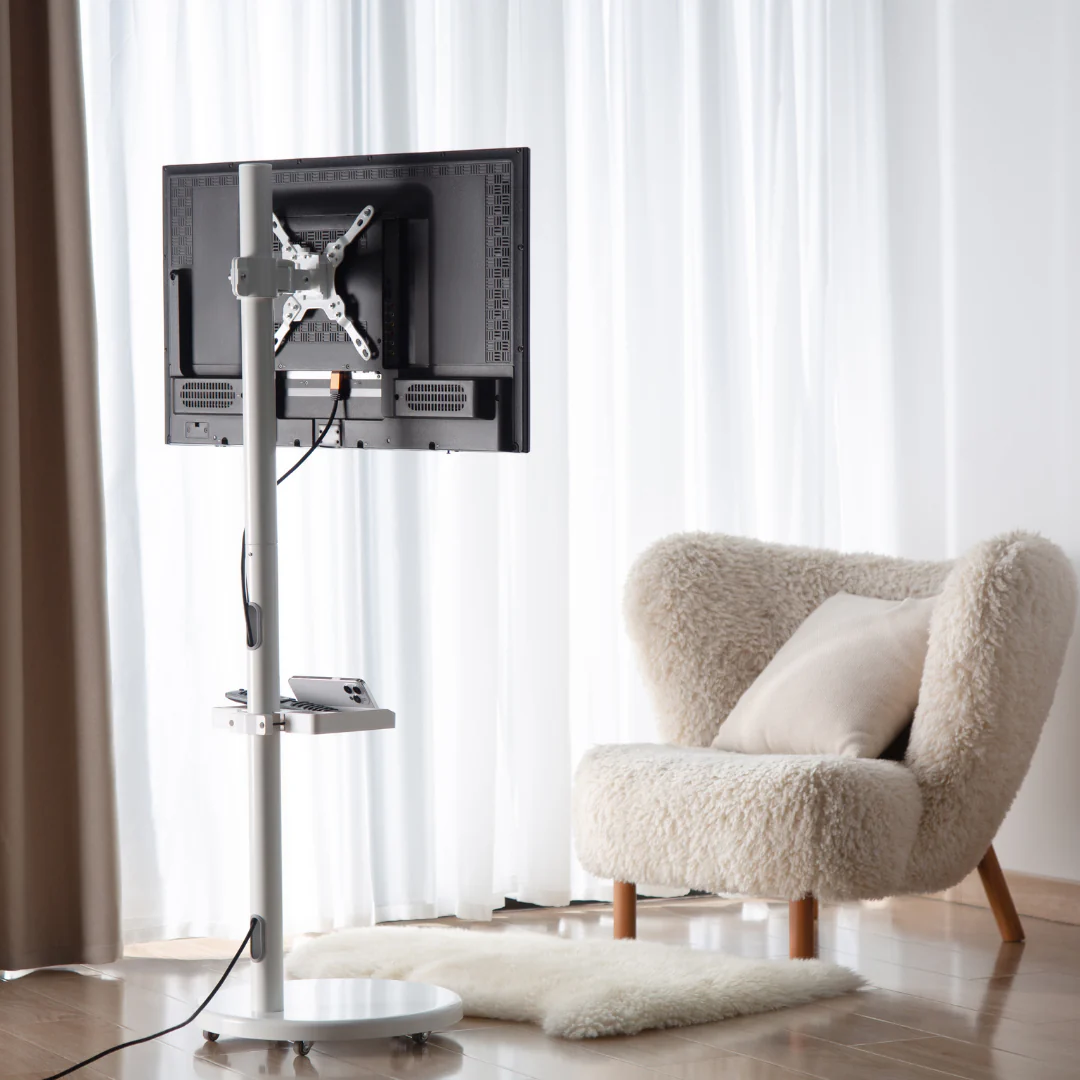In today’s fast-paced world, it’s crucial to optimize your workspace for both comfort and productivity. One of the best ways to achieve this is by incorporating a monitor floor stand into your setup. Whether you’re working from home or in a corporate office, having your monitor at the correct height can make a world of difference. In this comprehensive guide, we’ll explore the benefits of using a monitor floor stand, the factors to consider before purchasing one, and the top features to look for. By the end of this article, you will have all the information you need to make an informed decision and enhance your workspace.
What is a Monitor Floor Stand?
A monitor floor stand is a type of adjustable stand designed to elevate your computer monitor off your desk and position it at eye level. Unlike traditional monitor stands that sit directly on your desk, floor stands allow for greater flexibility, helping you achieve a more ergonomic and comfortable setup. These stands are often equipped with features like height adjustability, swivel capabilities, and even cable management to keep your workspace tidy.
Why Choose a Monitor Floor Stand?
The primary advantage of a monitor floor stand is its ability to improve your posture. When your monitor is positioned too low or too high, it can strain your neck and eyes. This can lead to discomfort, headaches, and long-term health issues. A monitor floor stand provides a customizable solution that allows you to adjust the height and angle of your screen to suit your needs.
In addition to enhancing comfort, monitor floor stands can also help you reclaim valuable desk space. By elevating your monitor, you create more room for other essential items like a keyboard, mouse, and paperwork. This can lead to a more organized and clutter-free workspace.
Benefits of Using a Monitor Floor Stand
Improved Ergonomics and Comfort
One of the most significant advantages of a monitor floor stand is improved ergonomics. By allowing you to adjust the height of your monitor, it ensures that your eyes are level with the screen, reducing neck strain and promoting a healthier posture. Proper ergonomics can minimize discomfort during long hours of work and prevent potential injuries.
Increased Desk Space
A floor stand helps free up space on your desk by elevating the monitor. This is particularly useful in smaller workspaces where desk space is limited. With more room available, you can organize your desk better, keeping only the essentials within reach and reducing clutter.
Versatility and Adjustability
Monitor floor stands often come with adjustable features, such as tilt, swivel, and height adjustments. Whether you’re working, gaming, or watching a movie, you can easily change the angle of your screen for the most comfortable viewing position.
Better Cable Management
Many monitor floor stands include built-in cable management systems to help keep your workspace tidy. These systems allow you to neatly bundle and route cables, preventing them from tangling or cluttering up your desk. This feature is especially useful if you have multiple devices connected to your monitor, such as a computer, laptop, or speakers.
Improved Posture and Health
Maintaining good posture while working is essential for long-term health. A monitor floor stand can help you achieve proper alignment, reducing the risk of musculoskeletal problems. By keeping your monitor at the correct height, you reduce the need to tilt your head or strain your neck, which can lead to discomfort and injuries over time.
Factors to Consider When Choosing a Monitor Floor Stand
When selecting a monitor floor stand, there are several factors to keep in mind. The right choice will depend on your specific needs, the size of your monitor, and your workspace setup. Here are some essential factors to consider:
Monitor Size Compatibility
Not all floor stands are compatible with all monitor sizes. It’s crucial to ensure that the stand you choose can support your monitor’s weight and size. Most stands are designed to accommodate monitors ranging from 13 to 32 inches, but it’s always a good idea to check the specifications to avoid any compatibility issues.
Height Adjustment Range
The height adjustment range is an essential feature to consider. Some stands offer a wide range of height adjustments, allowing you to position your monitor at the ideal eye level. If you’re taller or shorter than average, having this flexibility can significantly improve comfort and posture.
Stability and Durability
The stability of the stand is crucial to ensure that your monitor is securely positioned. A sturdy base and high-quality materials are essential for preventing wobbling or tipping. Look for stands made from durable materials such as steel or aluminum for long-lasting stability.
Swivel and Tilt Capabilities
Swivel and tilt capabilities allow you to adjust the angle of your monitor, improving your viewing experience. If you frequently share your screen with colleagues or family members, a swivel feature can be especially useful. Tilt adjustments also help reduce glare and improve visibility in different lighting conditions.
Ease of Installation
Installing a monitor floor stand should be a straightforward process. Look for stands that come with clear instructions and all the necessary hardware. Some stands even offer tool-free installation, making it easier to set up your new monitor stand without hassle.
Design and Aesthetics
While functionality is the most important consideration, the design of the stand can also impact the overall look of your workspace. Choose a monitor floor stand that complements your office or home decor. Many stands feature sleek, modern designs that can blend seamlessly with your existing furniture.
Top Features to Look for in a Monitor Floor Stand
When shopping for a monitor floor stand, it’s important to prioritize features that will enhance your experience. Here are some top features to look for:
Built-in Cable Management
Cable management systems are a must-have for a clutter-free workspace. Look for monitor floor stands with built-in cable management channels or clips to keep cables organized and out of sight. This feature is especially beneficial if you have multiple devices connected to your monitor.
VESA Compatibility
Most monitor floor stands are designed to be VESA compatible, which means they can fit monitors with VESA mounting patterns. VESA (Video Electronics Standards Association) is a standard used by most monitor manufacturers to ensure that their products can be easily mounted on stands and wall mounts. Be sure to check if your monitor is VESA-compatible before purchasing a stand.
Adjustable Arm or Mounting Plate
An adjustable arm or mounting plate allows you to position your monitor at different angles and heights. This flexibility is ideal for users who frequently switch between different tasks, such as typing, drawing, or video conferencing.
Shock Absorption
Some higher-end monitor floor stands feature shock absorption mechanisms that help reduce vibrations and provide a smoother viewing experience. This can be particularly beneficial if you’re working in a high-traffic area or on a desk that tends to shake.
Conclusion
A monitor floor stand is an essential addition to any workspace. It offers a range of benefits, including improved ergonomics, increased desk space, and better posture. By carefully considering the features and factors outlined in this guide, you can select the perfect monitor floor stand to enhance your productivity and comfort. Whether you’re working from home, gaming, or simply watching your favorite shows, the right monitor stand can make all the difference. Make the switch today and enjoy a more organized, comfortable, and efficient workspace.






Leave a Reply